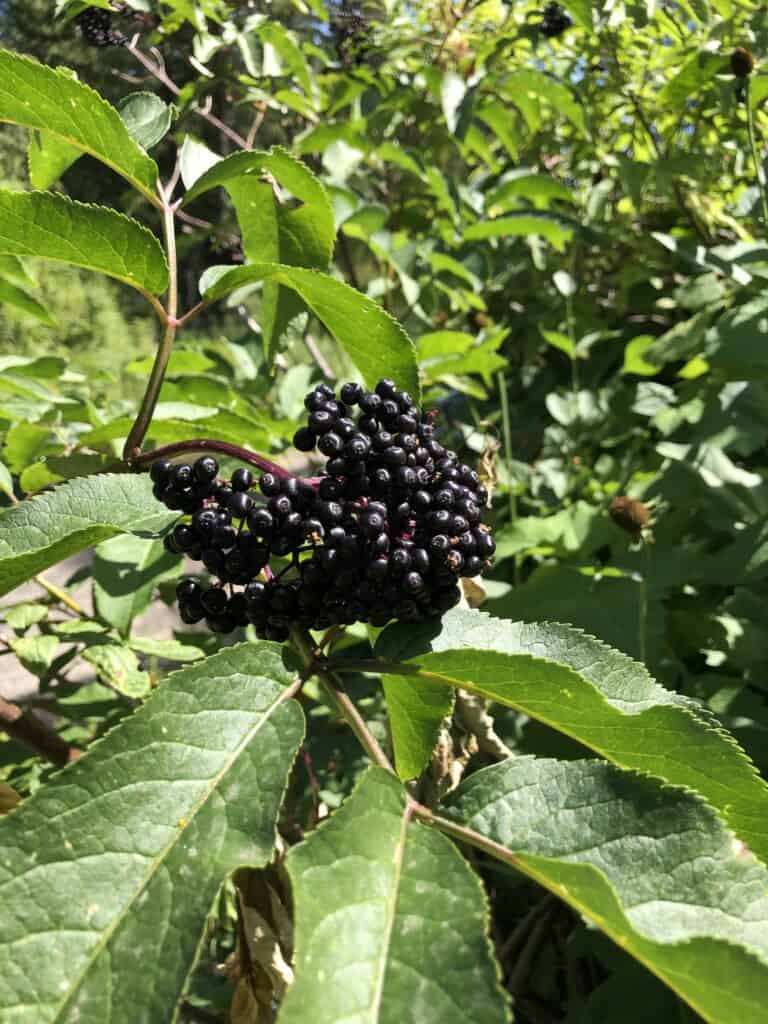Propagate Elderberries from Cuttings: How to Guide
This post will teach you how to propagate elderberry plants from hardwood cuttings on a budget. Growing elderberries at home can be rewarding and beneficial to your health!

Growing elderberries from cuttings can save you a ton of money over buying cuttings from a nursery. If you live in an area where elderberries grow wild like I do, you can propagate elderberry from cuttings for free from wild plants!
In addition to all the health benefits of elderberry syrup and jam, these plants provide great habitat and food for birds, deer, elk and moose! These plants also provide beautiful white flowers and light green foliage that will add beauty to your landscape.
It’s a good idea to grow elderberry shrubs at home.
Why Should You Grow Elderberries at Home?
American elderberry (Sambucus) are a genus of flowering native plants in the Adoxaceae family. They are native and widespread in North America, Europe and parts of South America.
Elderberry fruit is widely used to make syrup and jam and has been shown to help relieve flu and upper respiratory infection symptoms. There are two common varieties of elderberries: sambucus canadensis and sambucus nigra.
Some caution is necessary as uncooked elderberry fruit, leaves, branches, and seeds can have toxic properties. Don’t fret about this too much!
Cooking berries and extracting the juice for syrup or jelly renders it safe for consumption.
Using the tips below to propagate elderberry from cuttings will allow you to harvest elderberries right from your own backyard. Grow your own elderberries for homemade elderberry syrup, juice, and jams.
Best Time to Take Hardwood Cuttings for Elderberry Propagation
The best time of year to get cuttings from elderberries is in the late winter or early spring. It is ideal if you cut the branches before the leaf buds break open.
If you aren’t going to use the cuttings right away, you can place them in a clear plastic bag with a wet paper towel and put them in the refrigerator until you are ready to start the rooting process.
Elderberry Soil Requirements
Elderberries prefer rich, well drained, fertile soil with plenty of organic matter. If your soil is less than ideal, work in a few inches of compost before planting your elderberries.
Elderberry Light Requirements
Elderberries prefer full sun. While they can grow in shaded areas, they will be more productive if they have full access to sun. Pick a sunny spot to plant your elderberries.
The Best Way to Identify Elderberries in the Wild
- Look for a tall shrub from 9-12 feet tall with many branches billowing out from a common base
- Elderberry shrubs typically grow in moist habitats that have good drainage. In my area, they tend to grow in the forest on north or east-facing slopes.
- If you break a branch, you will often find that it is soft or hollow in the middle.
- The bark on new growth in smooth and brown.
- Leaves are 2-5 inches long, 1-2 inches wide, and light green with serrated edges. The leaves are slightly hairy.
- The leaves are in groups of 5-11 leaves that grow opposite from each other on 1 branch.
- Flowers are small and white in clusters at the end of the branch. Blooming usually occurs in July and August in North America.
- Blue, black or purple fruit forms in late summer in distinctive clusters. Unripe berries are green. Branches often bend with the weight of the fruit clusters.
How to Start Elderberry Cuttings
- In the late winter/early spring (late February in my area), locate proven elderberry bushes that you have harvested elderberries from in the past.
- Using sharp pruners, cut branches that are last years growth. Make a flat cut straight across the branch. These branches are often smaller and near the end of the branch. Make sure each branch has at least 4-6 leaf buds.
- Cut more branches than you think you will need as not all branches will successfully grow roots. I wanted to plant about 15-20 bushes, so I took 25 cuttings.
- Bring home these branches and soak the cut side of the branch in water for 24-48 hours. A 5 gallon bucket with some water in the bottom works great. You can add rooting hormone to the water to encourage growth, but it isn’t necessary.
- After the branches have soaked in water for 24 hours, push each branch into a pot with good potting mix and water well. You can put several branches in one pot as you will separate these later when you plant them outside. I put 5 branches in each 1/2 gallon pot.
- Place these potted cuttings in a dark cool place (I have mine in my unfinished basement) and check them every couple of days to make sure the potting soil is staying moist. We don’t want these to dry out!
- In 6-8 weeks these cuttings should have formed some roots. You can tell they have roots if you tug on the young plants gently and there is some resistance. Your new plants need enough roots to endure transplanting.
- These new plants can now be separated and planted in your desired location.
- Amend the soil with some good compost, potting soil, or organic matter and plant these cuttings 4-5 feet apart to allow them space to grow! It’s always a good idea to get a soil test!
- Your new elderberry plant will need frequent watering the first year to encourage root development. Keep soil moisture at optimum levels to encourage a better root system.

Shop Recommended Products
Go here to view and purchase products, supplies, and tools mentioned in this post.
Pin for later



